Synthesis of Pectin Hydrogels from Grapefruit Peel for the Adsorption of Heavy Metals from Water
Abstract
1. Introduction
1.1. Heavy Metal Contamination in Water and Effect on Human Health
1.2. Copper as a Heavy Metal
1.3. Nickel as a Heavy Metal
1.4. Removal of Heavy Metals from Water Using Biosorbents
1.5. Hydrogel Synthesis and Crosslinking
1.6. Pectin-Based Hydrogels from Grapefruit Peel
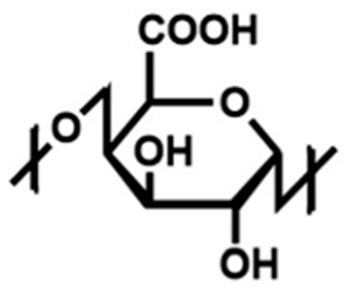
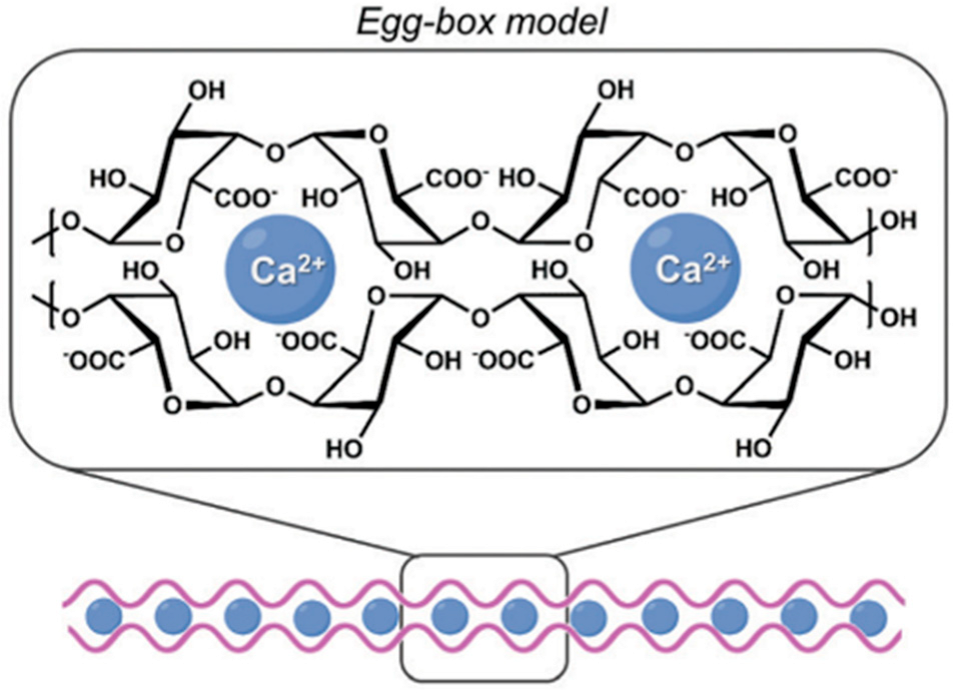
1.7. Flame Atomic Adsorption Spectroscopy
1.8. Study Aims
2. Materials and Methods
2.1. Materials and Reagents
2.2. Preparation of Grapefruit Peel Powder
2.3. Extraction of Pectin from Grapefruit Peel Powder
2.4. Method for the Synthesis of Pectin Hydrogels (PH)
2.5. Method for the Synthesis of Pectin Hydrogel–Metal Organic Framework (PHM Composite)
2.6. Characterization Techniques
2.6.1. FT-IR
2.6.2. SEM
2.6.3. Diameter Measurements
2.6.4. Water Adsorption Capacity
2.7. Heavy Metal Adsorption Assays
2.7.1. Effect of Contact Time on Heavy Metal Adsorption
2.7.2. Effect of Initial pH on Heavy Metal Adsorption
3. Results
3.1. Structural and Functional Characterization
3.1.1. FT-IR Comparison of Pectin vs. Pectin-Based Hydrogels (PH)
3.1.2. SEM Analysis of PH vs. PHM Composite
3.1.3. Diameter Size
3.1.4. Effect of Time on Water Adsorption Capacity
3.2. Batch Adsorption Tests for Copper and Nickel
3.2.1. Effect of Contact Time on Copper Adsorption by PH
3.2.2. Effect of Contact Time on Copper Adsorption by PHM Composite
3.2.3. Effect of Contact Time on Nickel Adsorption by PH
3.2.4. Effect of Initial pH on Copper Adsorption by PH
4. Discussion
5. Conclusions
Author Contributions
Funding
Institutional Review Board Statement
Informed Consent Statement
Data Availability Statement
Conflicts of Interest
References
- Mathew, B.B.; Jaishankar, M.; Biju, V.G.; Beeregowda, K.N. Role of Bioadsorbents in Reducing Toxic Metals. J. Toxicol. 2016, 2016, 4369604. [Google Scholar] [CrossRef]
- Ahmed, A.; Huo, A.; Ibrahim, M. Progressive Approaches in Ni(II) Contaminated Water Treatment: A Review of Adsorbent Strategies. Water Air Soil Pollut. 2024, 236, 5. [Google Scholar] [CrossRef]
- Giripunje, M.D.; Fulke, A.B.; Meshram, P.U. Remediation Techniques for Heavy-Metals Contamination in Lakes: A Mini-Review. CLEAN Soil Air Water 2015, 43, 1350–1354. [Google Scholar] [CrossRef]
- Awual, M.R. New Type Mesoporous Conjugate Material for Selective Optical Copper(II) Ions Monitoring & Removal from Polluted Waters. J. Chem. Eng. 2017, 307, 85–94. [Google Scholar] [CrossRef]
- Nie, J.; Feng, D.; Shang, J.; Nasen, B.; Jiang, T.; Liu, Y.; Hou, S. Green Composite Aerogel Based on Citrus Peel/Chitosan/Bentonite for Sustainable Removal Cu(II) from Water Matrices. Sci. Rep. 2023, 13, 15443. [Google Scholar] [CrossRef] [PubMed]
- Fitzgerald, D. Safety Guidelines for Copper in Water. Am. J. Clin. Nutr. 1998, 67, 1098S–1102S. [Google Scholar] [CrossRef]
- Antić, K.; Onjia, A.; Vasiljević-Radović, D.; Veličković, Z.; Tomić, S.L. Removal of Nickel Ions from Aqueous Solutions by 2-Hydroxyethyl Acrylate/Itaconic Acid Hydrogels Optimized with Response Surface Methodology. Gels 2021, 7, 225. [Google Scholar] [CrossRef]
- Wołowicz, A.; Wawrzkiewicz, M. Screening of Ion Exchange Resins for Hazardous Ni(II) Removal from Aqueous Solutions: Kinetic and Equilibrium Batch Adsorption Method. Processes 2021, 9, 285. [Google Scholar] [CrossRef]
- Zambelli, B.; Uversky, V.N.; Ciurli, S. Nickel Impact on Human Health: An Intrinsic Disorder Perspective. Biochim. Biophys. Acta-Proteins Proteom. 2016, 1864, 1714–1731. [Google Scholar] [CrossRef]
- Darban, Z.; Shahabuddin, S.; Gaur, R.; Ahmad, I.; Sridewi, N. Hydrogel-Based Adsorbent Material for the Effective Removal of Heavy Metals from Wastewater: A Comprehensive Review. Gels 2022, 8, 263. [Google Scholar] [CrossRef]
- Qasem, N.A.A.; Mohammed, R.H.; Lawal, D.U. Removal of Heavy Metal Ions from Wastewater: A Comprehensive and Critical Review. NPJ Clean Water 2021, 4, 36. [Google Scholar] [CrossRef]
- Hossain, M.S.; Hossain, M.M.; Khatun, M.K.; Hossain, K.R. Hydrogel-Based Superadsorbents for Efficient Removal of Heavy Metals in Industrial Wastewater Treatment and Environmental Conservation. EFM 2023, 2, 142–158. [Google Scholar] [CrossRef]
- Mahmoud, M.E.; Mohamed, A.K. Novel Derived Pectin Hydrogel from Mandarin Peel Based Metal-Organic Frameworks Composite for Enhanced Cr(VI) and Pb(II) Ions Removal. Int. J. Biol. Macromol. 2020, 164, 920–931. [Google Scholar] [CrossRef]
- Li, Z.-Q.; Yang, J.-C.; Sui, K.-W.; Yin, N. Facile Synthesis of Metal-Organic Framework MOF-808 for Arsenic Removal. Mater. Lett. 2015, 160, 412–414. [Google Scholar] [CrossRef]
- Bustamante-Torres, M.; Romero-Fierro, D.; Arcentales-Vera, B.; Palomino, K.; Magaña, H.; Bucio, E. Hydrogels Classification According to the Physical or Chemical Interactions and as Stimuli-Sensitive Materials. Gels 2021, 7, 182. [Google Scholar] [CrossRef]
- Said, N.S.; Olawuyi, I.F.; Lee, W.Y. Pectin Hydrogels: Gel-Forming Behaviors, Mechanisms, and Food Applications. Gels 2023, 9, 732. [Google Scholar] [CrossRef]
- Öztürk, T.; Özbek, H.N.; Koçak Yanık, D. Environmentally Friendly Approach to Pectin Extraction from Grapefruit Peel: Microwave-Assisted High-Pressure CO2/H2O. Foods 2024, 13, 476. [Google Scholar] [CrossRef] [PubMed]
- Wang, Y.; Zhao, Y.; He, J.; Sun, C.; Lu, W.; Zhang, Y.; Fang, Y. Doubling Growth of Egg-Box Structure during Calcium-Mediated Molecular Assembly of Alginate. J. Colloid Interface Sci. 2023, 634, 747–756. [Google Scholar] [CrossRef]
- Tortorella, S.; Inzalaco, G.; Dapporto, F.; Maturi, M.; Sambri, L.; Vetri Buratti, V.; Chiariello, M.; Comes Franchini, M.; Locatelli, E. Biocompatible Pectin-Based Hybrid Hydrogels for Tissue Engineering Applications. New J. Chem. 2021, 45, 22386–22395. [Google Scholar] [CrossRef]
- Moldovan, M. Atomic Absorption Spectrometry—Flame. In Encyclopedia of Analytical Science, 3rd ed.; Worsfold, P., Poole, C., Townshend, A., Miró, M., Eds.; Elsevier: Amsterdam, The Netherlands, 2018; p. 9780124095472000226. [Google Scholar] [CrossRef]
- Guerra, R. WATER ANALYSIS|Industrial Effluents. In Encyclopedia of Analytical Science, 2nd ed.; Worsfold, P., Townshend, A., Poole, C., Eds.; Elsevier: Amsterdam, The Netherlands, 2005; pp. 289–299. [Google Scholar] [CrossRef]
- Bagherian, G.; Arab Chamjangali, M.; Shariati Evari, H.; Ashrafi, M. Determination of Copper(II) by Flame Atomic Absorption Spectrometry after Its Perconcentration by a Highly Selective and Environmentally Friendly Dispersive Liquid–Liquid Microextraction Technique. J. Anal. Sci. Technol. 2019, 10, 3. [Google Scholar] [CrossRef]
- Khorrami, A. Determination of Nickel in Natural Waters by FAAS after Sorption on Octadecyl Silica Membrane Disks Modified with a Recently Synthesized Schiff? Talanta 2004, 64, 13–17. [Google Scholar] [CrossRef]
- Mishra, R.K.; Majeed, A.B.A.; Banthia, A.K. Development and Characterization of Pectin/Gelatin Hydrogel Membranes for Wound Dressing. Int. J. Plast. Technol. 2011, 15, 82–95. [Google Scholar] [CrossRef]
- Güzel, M.; Akpınar, Ö. Valorisation of Fruit By-Products: Production Characterization of Pectins from Fruit Peels. FBP 2019, 115, 126–133. [Google Scholar] [CrossRef]
- Wang, W.; Ma, X.; Jiang, P.; Hu, L.; Zhi, Z.; Chen, J.; Ding, T.; Ye, X.; Liu, D. Characterization of Pectin from Grapefruit Peel: A Comparison of Ultrasound-Assisted and Conventional Heating Extractions. Food Hydrocoll. 2016, 61, 730–739. [Google Scholar] [CrossRef]
- Seida, Y.; Tokuyama, H. Hydrogel Adsorbents for the Removal of Hazardous Pollutants—Requirements and Available Functions as Adsorbent. Gels 2022, 8, 220. [Google Scholar] [CrossRef]
- Rumyanceva, O. Pectin Changes during Freezing and Storage of Plant Products. Food Process. Tech. Technol. 2024, 54, 495–507. [Google Scholar] [CrossRef]
- Marquis, M.; Davy, J.; Fang, A.; Renard, D. Microfluidics-Assisted Diffusion Self-Assembly: Toward the Control of the Shape and Size of Pectin Hydrogel Microparticles. Biomacromolecules 2014, 15, 1568–1578. [Google Scholar] [CrossRef]
- Ullrich, S.; Seyferth, S.; Lee, G. Measurement of Shrinkage and Cracking in Lyophilized Amorphous Cakes. Part IV: Effects of Freezing Protocol. Int. J. Pharm. 2015, 495, 52–57. [Google Scholar] [CrossRef]
- Shen, B.; Guo, Z.; Huang, B.; Zhang, G.; Fei, P.; Hu, S. Preparation of Hydrogels Based on Pectin with Different Esterification Degrees and Evaluation of Their Structure and Adsorption Properties. Int. J. Biol. Macromol. 2022, 202, 397–406. [Google Scholar] [CrossRef]
- Popov, S.; Paderin, N.; Chistiakova, E.; Ptashkin, D.; Markov, P.A. Effect of Cross-Linking Cations on In Vitro Biocompatibility of Apple Pectin Gel Beads. Int. J. Mol. Sci. 2022, 23, 14789. [Google Scholar] [CrossRef]
- Kulkarni, R.M.; Dhanyashree, J.K.; Varma, E.; Sirivibha, S.P. Batch and Continuous Packed Bed Column Studies on Biosorption of Nickel (II) by Sugarcane Bagasse. Results Chem. 2022, 4, 100328. [Google Scholar] [CrossRef]
- Hu, X.; Yan, L.; Wang, Y.; Xu, M. Smart and Functional Polyelectrolyte Complex Hydrogel Composed of Salecan and Chitosan Lactate as Superadsorbent for Decontamination of Nickel Ions. Int. J. Biol. Macromol. 2020, 165, 1852–1861. [Google Scholar] [CrossRef] [PubMed]
- Zhang, W.; Hu, L.; Hu, S.; Liu, Y. Optimized Synthesis of Novel Hydrogel for the Adsorption of Copper and Cobalt Ions in Wastewater. RSC Adv. 2019, 9, 16058–16068. [Google Scholar] [CrossRef] [PubMed]
- Opanasopit, P.; Apirakaramwong, A.; Ngawhirunpat, T.; Rojanarata, T.; Ruktanonchai, U. Development and Characterization of Pectinate Micro/Nanoparticles for Gene Delivery. AAPS Pharm. Sci. Tech. 2008, 9, 67–74. [Google Scholar] [CrossRef]
- Lin, Y.E.; Vidic, R.D.; Stout, J.E.; Yu, V.L. Negative Effect of High pH on Biocidal Efficacy of Copper and Silver Ions in Controlling Legionella Pneumophila. Appl. Environ. Microbiol. 2002, 68, 2711–2715. [Google Scholar] [CrossRef]
- Zhang, L.; Li, R.; Zheng, S.; Zhu, H.; Cao, M.; Li, M.; Hu, Y.; Long, L.; Feng, H.; Tang, C.Y. Hydrogel-Embedded Vertically Aligned Metal-Organic Framework Nanosheet Membrane for Efficient Water Harvesting. Nat. Commun. 2024, 15, 9738. [Google Scholar] [CrossRef]
- Zhang, X.; Li, Z.; Zhang, T.; Chen, J.; Ji, W.; Wei, Y. Fabrication of an Efficient ZIF-8 Alginate Composite Hydrogel Material and Its Application to Enhanced Copper(II) Adsorption from Aqueous Solutions. New J. Chem. 2021, 45, 15876–15886. [Google Scholar] [CrossRef]
- Sulianto, A.A.; Nugroho, W.A.; Wibisono, Y.; Drannikov, A.A.; Ozaltin, K.; Safitri, A.; Azzahrah, A.R.P.; Bakshia, M.I.; Fatriasari, W.; Martino, A.D. Pectin-based Hydrogels Produced from Banana and Mango Peels as a Potential Approach to Removing Heavy Metal Ions from Contaminated Water. Appl. Sci. Eng. Prog. 2025, 18, 7717. [Google Scholar] [CrossRef]
- Li, J.; Yang, Z.; Ding, T.; Song, Y.; Li, H.; Li, D.; Chen, S.; Xu, F. The role of surface functional groups of pectin and pectin-based materials on the adsorption of heavy metal ions and dyes. Carbohydr. Polym. 2022, 276, 118789. [Google Scholar] [CrossRef]
- Lou, H.; Cao, X.; Yan, X.; Wang, L.; Chen, Z. Adsorption performance of Cd (II), Cr (III), Cu (II), Ni (II), Pb (II) and Zn (II) by aminated solution-blown polyacrylonitrile micro/nanofibers. Water Sci. Technol. 2018, 2017, 378–389. [Google Scholar] [CrossRef]
- Bohli, T.; Ouederni, A.; Villaescusa, I. Simultaneous adsorption behavior of heavy metals onto microporous olive stones activated carbon: Analysis of metal interactions. Euro-Mediterr. J. Environ. Integr. 2017, 2, 19. [Google Scholar] [CrossRef]
- Kalantari, K.; Ahmad, M.B.; Masoumi, H.R.F.; Shameli, K.; Basri, M.; Khandanlou, R. Rapid adsorption of heavy metals by Fe3O4/talc nanocomposite and optimization study using response surface methodology. Int. J. Mol. Sci. 2014, 15, 12913–12927. [Google Scholar] [CrossRef]
- Tansel, B. Significance of thermodynamic and physical characteristics on permeation of ions during membrane separation: Hydrated radius, hydration free energy and viscous effects. Sep. Purif. Technol. 2012, 86, 119–126. [Google Scholar] [CrossRef]
- Sulianto, A.A.; Adiyaksa, I.P.; Wibisono, Y.; Khan, E.; Ivanov, A.; Drannikov, A.; Ozaltin, K.; Di Martino, A. From Fruit Waste to Hydrogels for Agricultural Applications. Clean Technol. 2023, 6, 1–17. [Google Scholar] [CrossRef]
- Ribeiro, J.G.; Raimondi, R.M.; de Souza, A.G.; dos Santos Rosa, D.; Paulino, A.T. An Ecofriendly Pectin-Co-Montmorillonite Composite Hydrogel for the Separation of Contaminant Metal Ions from Water. J. Water Process Eng. 2025, 69, 106629. [Google Scholar] [CrossRef]
- Haque, S.M.; Kabir, A.; Ratemi, E.; Elzagheid, M.; Appu, S.P.; Ghani, S.S.; Sarief, A. Greener Pectin Extraction Techniques: Applications and Challenges. Separations 2025, 12, 65. [Google Scholar] [CrossRef]
- Costa, J.M.; Wang, W.; Nakasu, P.Y.S.; Hu, C.; Forster-Carneiro, T.; Hallett, J.P. Impacts of Microwaves on the Pectin Extraction from Apple Pomace: Technological Properties in Structuring of Hydrogels. Food Hydrocoll. 2025, 160, 110766. [Google Scholar] [CrossRef]
- Anoraga, S.B.; Shamsudin, R.; Hamzah, M.H.; Sharif, S.; Saputro, A.D.; Basri, M.S.M. Optimization of Subcritical Water Extraction for Pectin Extraction from Cocoa Pod Husks Using the Response Surface Methodology. Food Chem. 2024, 459, 140355. [Google Scholar] [CrossRef]
- Milošević, M.M.; Antov, M.G. Pectin from Butternut Squash (Cucurbita Moschata)–The Effect of Enzyme-Assisted Extractions on Fiber Characteristics and Properties. Food Hydrocoll. 2022, 123, 107201. [Google Scholar] [CrossRef]
- Singla, M.; Sit, N. Application of Ultrasound in Combination with Other Technologies in Food Processing: A Review. Ultrason. Sonochemistry 2021, 73, 105506. [Google Scholar] [CrossRef]
- Tariq, W.; Arslan, C.; Tayyab, N.; Rashid, H.; Nasir, A. Application of Agro-Based Adsorbent for Removal of Heavy Metals. In Emerging Techniques for Treatment of Toxic Metals from Wastewater; Ahmad, A., Kumar, R., Jawaid, M., Eds.; Elsevier: Amsterdam, The Netherlands, 2023; pp. 157–182. [Google Scholar] [CrossRef]
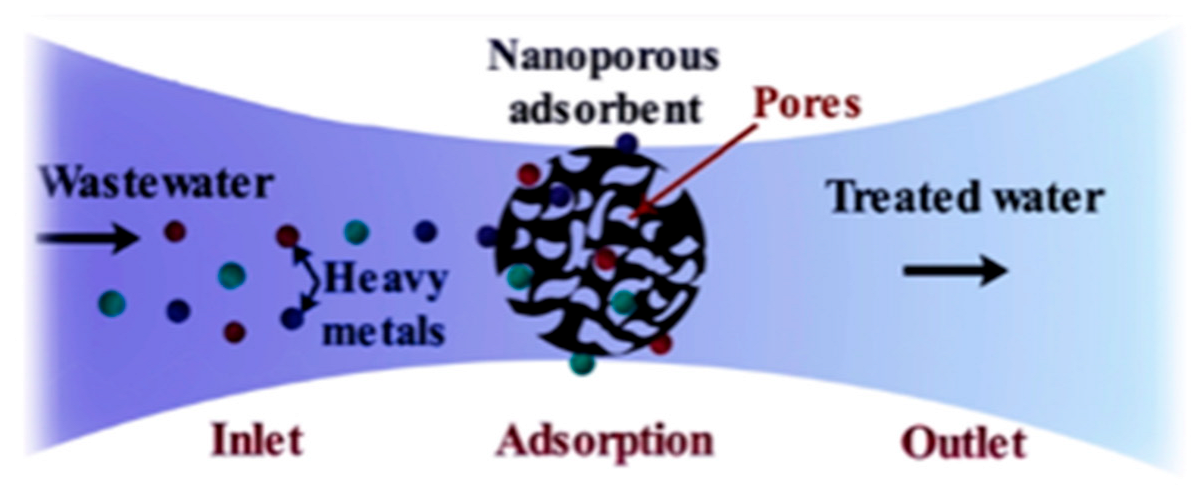
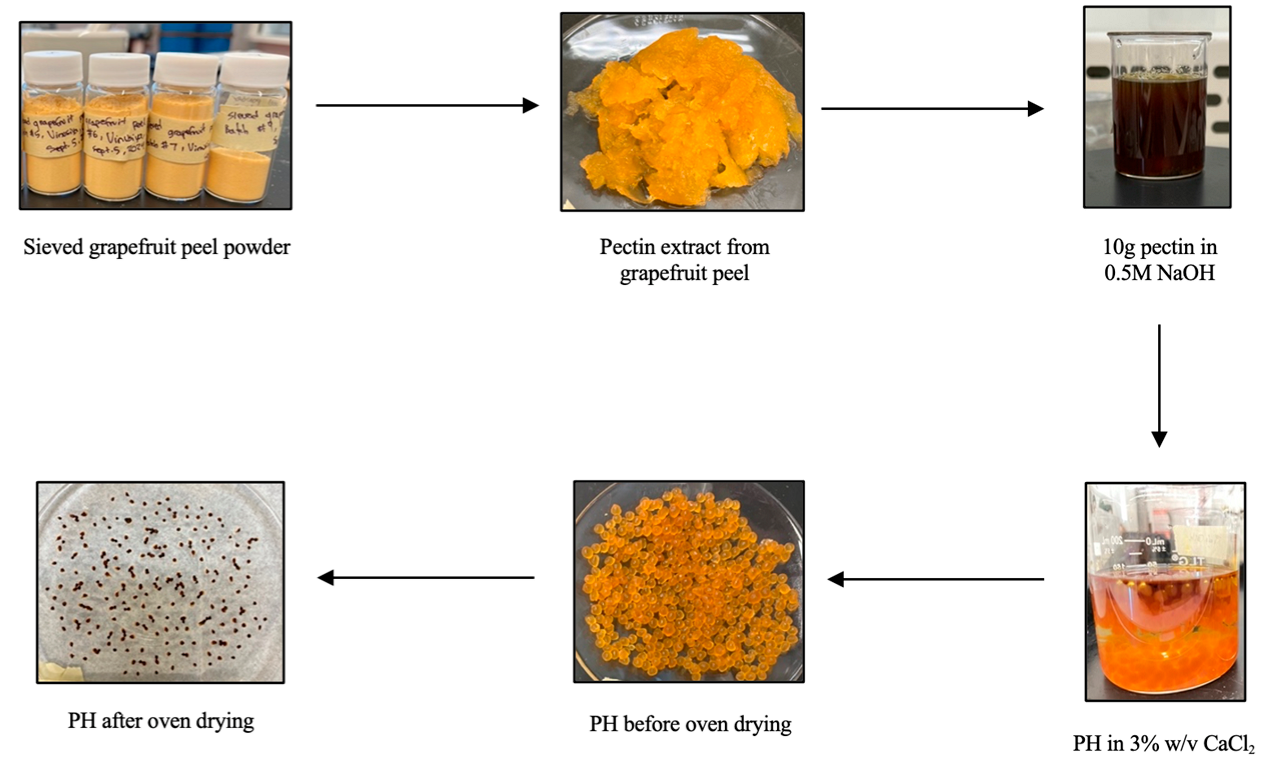
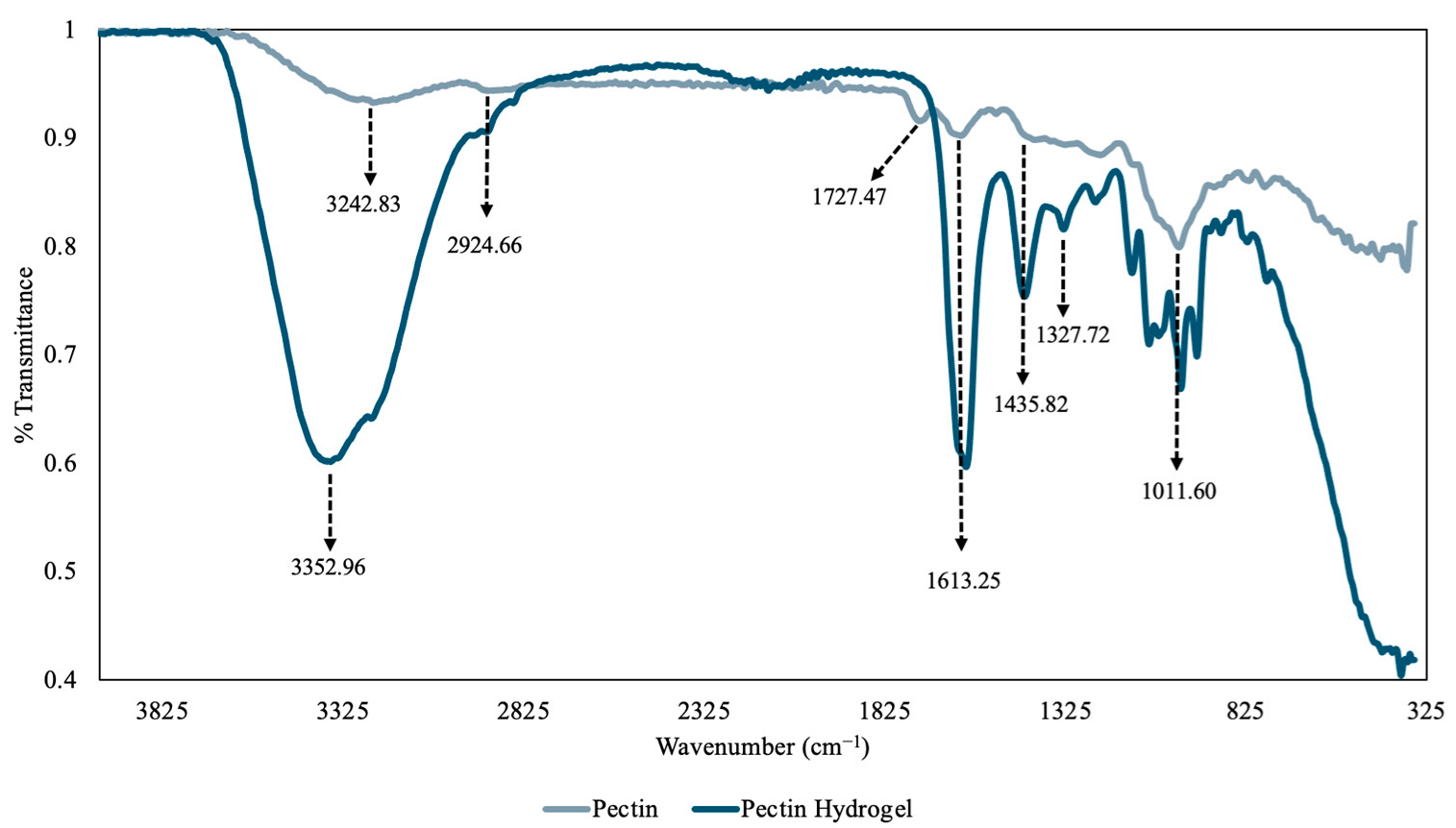



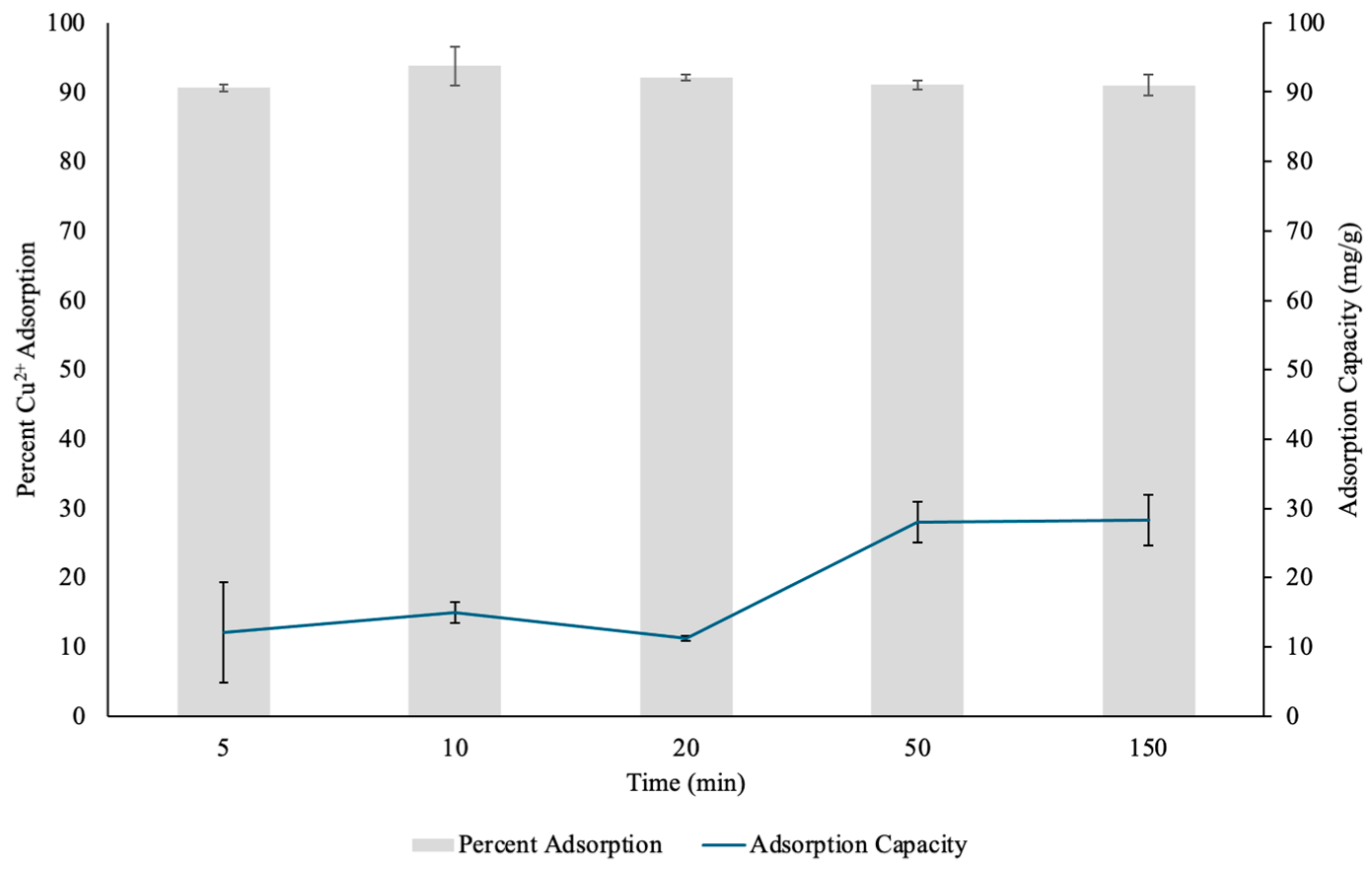
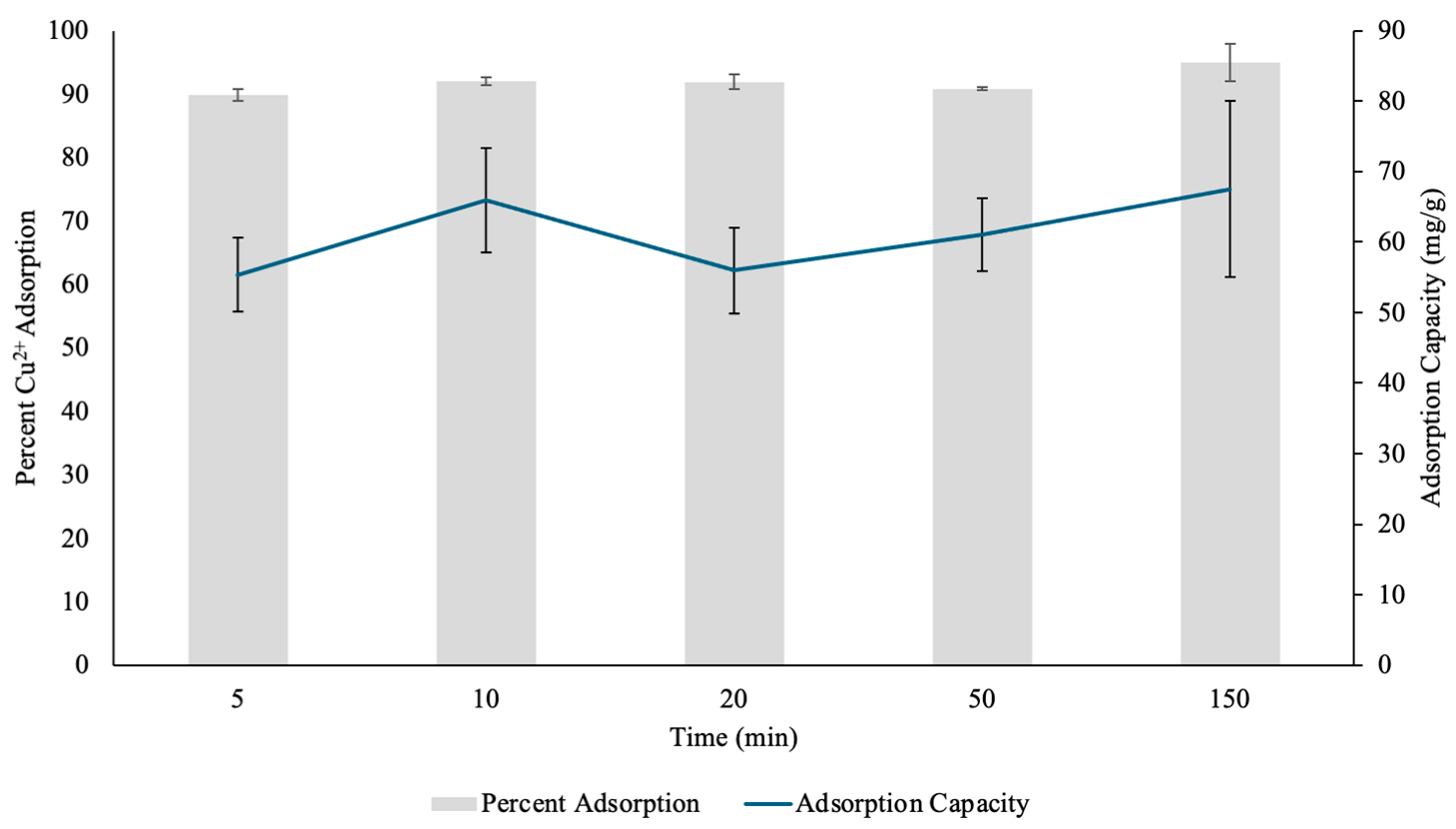

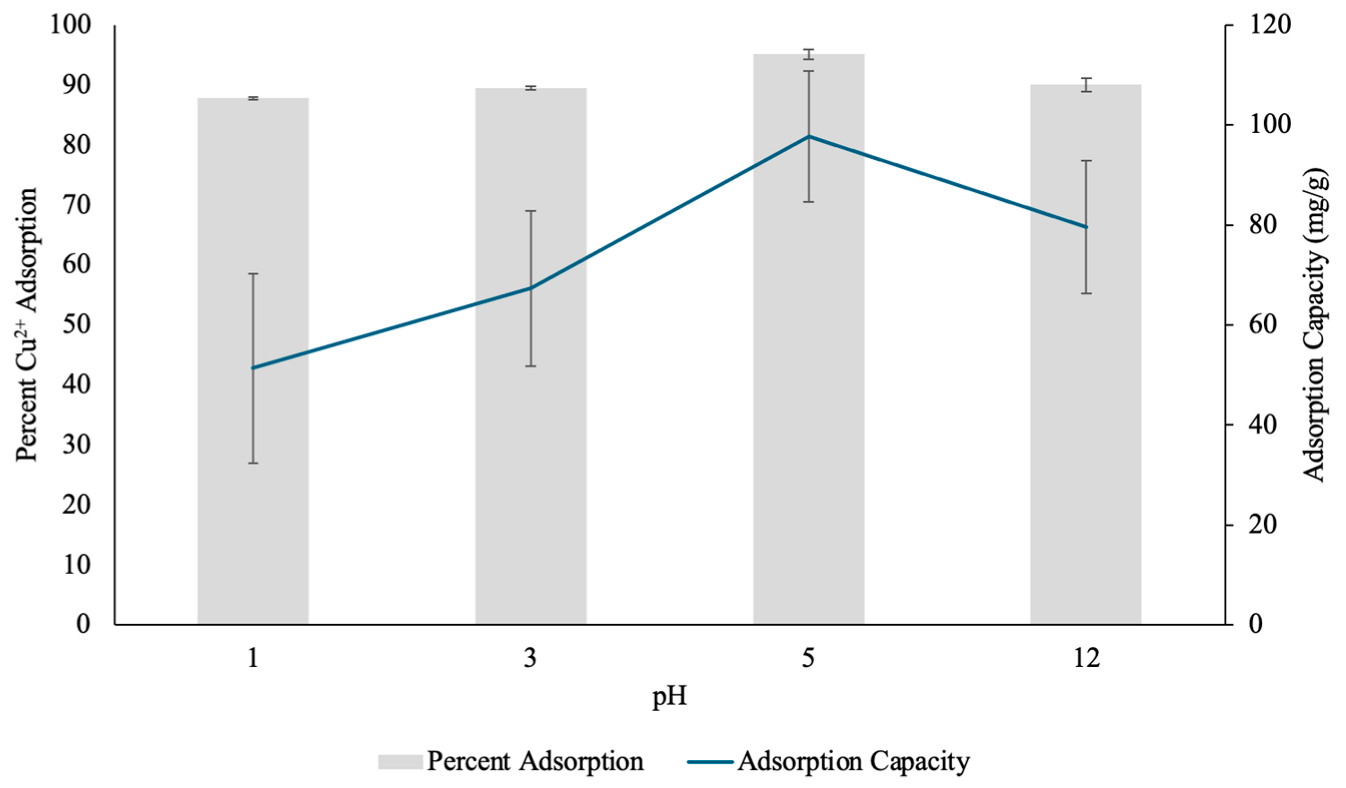
| Type of Hydrogel | Wet or Dry | Average Diameter Size (mm) ± Standard Deviation (mm) |
|---|---|---|
| Pectin Hydrogel (PH) | Wet | 4.58 ± 0.49 |
| Dry | 1.67 ± 0.26 | |
| Pectin Hydrogel–Metal Organic Framework (PHM composite) | Dry | 1.05 ± 0.12 |
Disclaimer/Publisher’s Note: The statements, opinions and data contained in all publications are solely those of the individual author(s) and contributor(s) and not of MDPI and/or the editor(s). MDPI and/or the editor(s) disclaim responsibility for any injury to people or property resulting from any ideas, methods, instructions or products referred to in the content. |
© 2025 by the authors. Licensee MDPI, Basel, Switzerland. This article is an open access article distributed under the terms and conditions of the Creative Commons Attribution (CC BY) license (https://creativecommons.org/licenses/by/4.0/).
Share and Cite
Vigneswararajah, V.; Thavarajah, N.; Fernando, X. Synthesis of Pectin Hydrogels from Grapefruit Peel for the Adsorption of Heavy Metals from Water. Technologies 2025, 13, 403. https://doi.org/10.3390/technologies13090403
Vigneswararajah V, Thavarajah N, Fernando X. Synthesis of Pectin Hydrogels from Grapefruit Peel for the Adsorption of Heavy Metals from Water. Technologies. 2025; 13(9):403. https://doi.org/10.3390/technologies13090403
Chicago/Turabian StyleVigneswararajah, Vinusiya, Nirusha Thavarajah, and Xavier Fernando. 2025. "Synthesis of Pectin Hydrogels from Grapefruit Peel for the Adsorption of Heavy Metals from Water" Technologies 13, no. 9: 403. https://doi.org/10.3390/technologies13090403
APA StyleVigneswararajah, V., Thavarajah, N., & Fernando, X. (2025). Synthesis of Pectin Hydrogels from Grapefruit Peel for the Adsorption of Heavy Metals from Water. Technologies, 13(9), 403. https://doi.org/10.3390/technologies13090403






